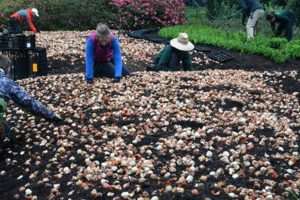By Juliette Coulter

The Dallas Arboretum and Botanical Garden’s horticultural staff, with the help of up to 30 additional seasonal gardeners, are laying out and planting more than 500,000 spring-blooming bulbs throughout the 66-acre garden. As one of the city’s dirtiest jobs, these gardeners know that their hard work will result in the most spectacular floral festival of the year, Dallas Blooms, which debuts February 23 and runs through April 7, 2019.
Planting bulbs is an integral part of the gardening cycle, and it takes 65 Arboretum staff members to plant and produce the beautiful floral displays each spring. The bulbs are ordered from Abbott Ipco, and it takes roughly 11,560 man hours to plant them.
The horticulture team begins by amending the soil and removing existing mums, adding compost, broadcasting bone meal- bulb fertilizer with a hand spreader, and adding blood meal to keep away squirrels and birds.
“Bulbs need to be chilled in a refrigerator for four to six weeks before planting, and soil temperatures need to be 50 degrees or lower when planting the bulbs to ensure the tulips don’t bloom too early,” said Dave Forehand, vice president of gardens.
The Dallas Arboretum horticultural staff plants the bulbs in staggered rows, spaced two to three inches apart, depending on the type of bulb. Other spring-blooming annuals such as pansies, are planted above the bulbs so the beds are full of blooming plants until the bulbs make their appearance in the spring.
Forehand added: “Remember that you still need to fertilize and water during the winter. Watering before a freeze insulates the plant and saves it from freezing, so always water, if a freeze is predicted. Pansies, kale and poppies survive a freeze so you don’t have to cover. The types of spring-blooming bulbs being planted include a wide variety of tulips, daffodils and hyacinths, in addition to 100,000 pansies, violas and thousands of other spring-blooming annuals.”
